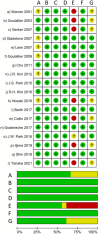Fatty infiltration predicts retear and functional impairment following rotator cuff repair: systematic review and meta-analysis
- PMID: 40119431
- PMCID: PMC11929350
- DOI: 10.1186/s13018-025-05702-6
Fatty infiltration predicts retear and functional impairment following rotator cuff repair: systematic review and meta-analysis
Abstract
Introduction: Fatty infiltration (FI) in rotator cuff (RC) is detected in many patients with complete RC tears. But there remains controversy on the prognostic effects of FI in RC tears, especially for patients with moderate and severe FI. This study aims to systematically review the relationship between the severity of preoperative FI and risk of retear, and the association between preoperative FI and functional outcomes.
Materials and methods: We searched PubMed, Embase and Web of Science for studies on association between preoperative FI and retear or functional outcomes following complete RC repair. FI was assessed using Goutallier classification and global fatty degeneration index (GFDI). Meta-analysis was performed to determine odds ratios (ORs) for retear among patients with mild (grade 0-1), moderate (grade 2) and severe (grade 3-4) FI in RC tears. We delivered qualitative synthesis on association between FI and functional outcomes.
Results: Eighteen studies with 1997 patients were included in the systematic review and ten studies were included in the meta-analysis. Patients with GFDI ≤ 1 had lower retear odds (OR = 0.08, 95%CI 0.02-0.29, p < 0.01). Moderate FI in supraspinatus muscle (SSP) was associated with higher retear odds compared with mild FI (OR = 1.95, 95%CI 1.09-3.48, p = 0.02) and severe FI was associated with more retear compared with moderate FI (OR = 3.37, 95%CI 1.08-10.53, p = 0.04). Similar effects were observed in FI in infraspinatus muscle (ISP) (moderate vs. mild: OR = 2.22, 95%CI 1.07-4.62, p = 0.03; severe vs. moderate: OR = 2.06, 95%CI 1.02-4.16, p = 0.04). The severity of FI in subscapularis muscle and teres minor muscle was not observed to be associated with the retear rates. In functional outcomes, lower grade of FI in GFDI was associated with better prognosis. FI in single muscles failed to present prognostic effects on functional outcomes.
Conclusions: The severity of FI in SSP and ISP showed effects on retear following complete RC repair. The GFDI was a compatible predictor for risk of anatomic and functional impairment.
Keywords: Clinical assessment; Fatty infiltration; Imaging, computed tomography; Imaging, magnetic resonance; Shoulder, rotator cuff; Surgery.
© 2025. The Author(s).
Conflict of interest statement
Declarations. Competing interests: The study was approved by National Key Research and Development Program of China (No. 2022YFC2505500). All authors declare no other conflicts of interest concerning this work.
Figures






References
-
- McElvany MD, McGoldrick E, Gee AO, Neradilek MB, Matsen FA 3rd. Rotator cuff repair: published evidence on factors associated with repair integrity and clinical outcome. Am J Sports Med. 2015;43:491–500. 10.1177/0363546514529644. - PubMed
-
- Bedi A, Bishop J, Keener J, et al. Rotator cuff tears. Nat Rev Dis Primers. 2024;10:8. 10.1038/s41572-024-00492-3. - PubMed
-
- Lapner P, Henry P, Athwal GS, Moktar J, McNeil D, MacDonald P. Treatment of rotator cuff tears: a systematic review and meta-analysis. J Shoulder Elb Surg. 2022;31:e120–9. 10.1016/j.jse.2021.11.002. - PubMed
-
- Maffulli N, Nilsson Helander K, Migliorini F. Tendon appearance at imaging May be altered, but it May not indicate pathology. Knee Surg Sports Traumatol Arthrosc. 2023;31:1625–8. 10.1007/s00167-023-07339-6. - PubMed
-
- Oh JH, Kim SH, Ji HM, Jo KH, Bin SW, Gong HS. Prognostic factors affecting anatomic outcome of rotator cuff repair and correlation with functional outcome. Arthroscopy. 2009;25:30–9. 10.1016/j.arthro.2008.08.010. - PubMed
Publication types
MeSH terms
Grants and funding
LinkOut - more resources
Full Text Sources
Medical

